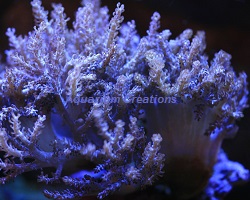Description
The Kenya Tree, Capnella sp., is a hardy soft coral species that is tolerant of a range of living conditions, which makes it great for beginner aquarists. In terms of color, this rapidly growing soft coral species is generally available as a coco or golden color, and sometimes pinkish. There is a more expensive Green Kenya Tree Coral that is a neon green under Blue actinic lighting. Kenya Tree is also called Capnella coral, Cauliflower coral, Nephthea coral, or Nephthya coral. As its name implies, the Kenya Tree Coral is shaped like a tree with a thick trunk and beautiful branches. A leather coral from the Indo Pacific regions of the world. It is known to be a quick grower given proper lighting and good water flow.
Kenya Tree coral is a great coral species for learning how to culture corals (coral propagation). Besides how hardy Kenya Tree corals are in the aquarium, they are real easy to aquaculture into smaller kenya tree corals and watch them grow. Small colonies will quickly grow in reef tanks . Another form of new culturing of the kenya tree is from the Kenya Tree coral actually doing what's called "dropping branches". This self-propagation is a form of culturing corals that a growing kenya tree coral specimen will undergo all on its own. The dropped branches can then be placed on rubble rock, or anywhere for the new colony to form. From the tiniest little bit of Kenya Tree Coral a new Kenya Tree coral will grow back. If left alone it will take hold to any substrate to which it attaches.
Like most Leather corals, Kenya Tree corals will routinely shed a “mucous tunic” to clear itself of algae, debris, etc. This is generally observed by the colony closing for a period of hours to a few days, followed by a shedding of a thin clear film that may take one to several days to complete. Colonies kept in higher flow areas will “shed” less often.
Care Level
Easy
Aggressiveness
Peaceful
Lighting & Flow Requirements
The Kenya Tree requires a moderate to strong water flow and tends to do very well under various types of reef tank lighting. Lighting can be Power compacts, T5's, LED's or even Metal Halides. All lighting can grow the Kenya Tree Coral as long as the proper level of light is provided. If a Par meter is available the appropriate lighting level is anywhere from a Par 100 all the way to a Par 250. Which is a wide range of acceptability. For lighting spectrum use between a 14-20K color spectrum for your bulbs for best coral coloration.
Diet and Feeding
Although the Kenya Tree Coral receives a portion of its nutritional requirements through the process of photosynthesis, which simply means their lighting creates symbiotic algae called zooxanthellae in the body of the leather coral which provides its nutrition, the Kenya Tree Coral relies less on the process of photosynthesis, and depends more on obtaining outside food. Microplankton, marine snow, and dissolved materials should make up the bulk of its diet. We do recommend providing supplemental food such as micro-plankton, baby brine shrimp, or foods designed for filter feeding invertebrates.
|



